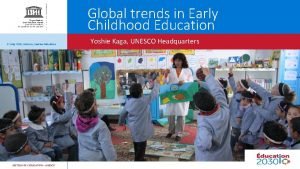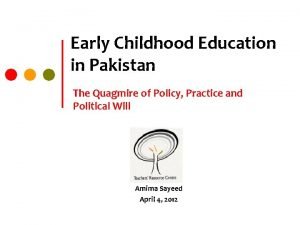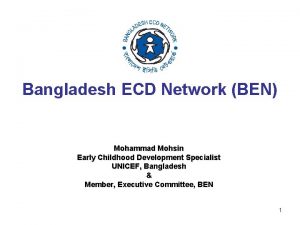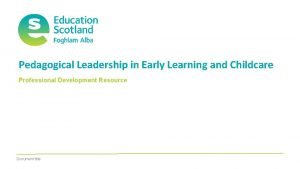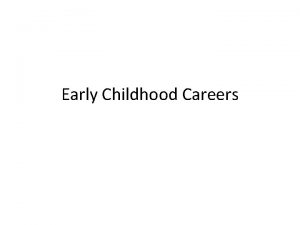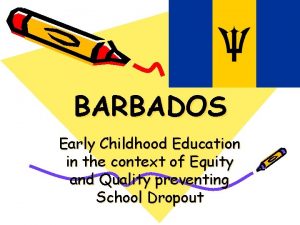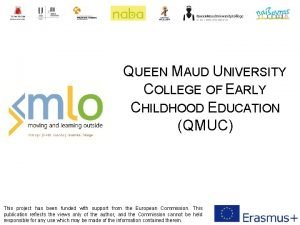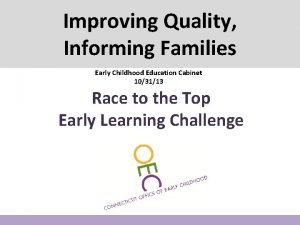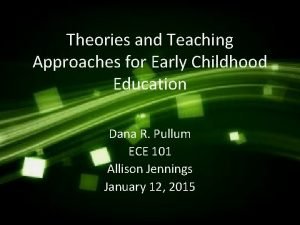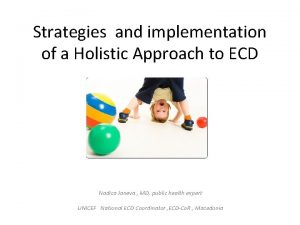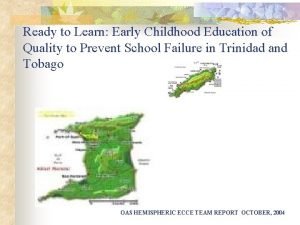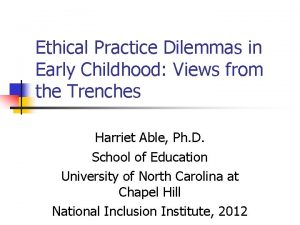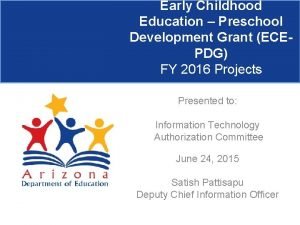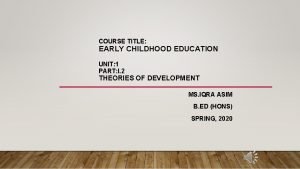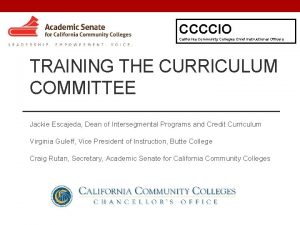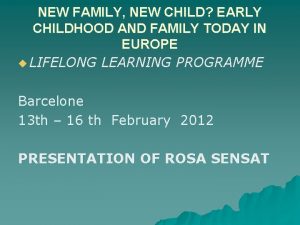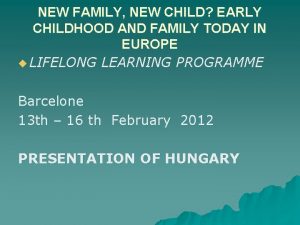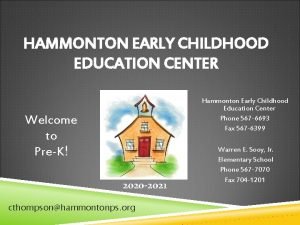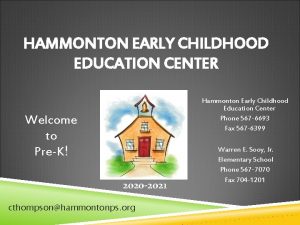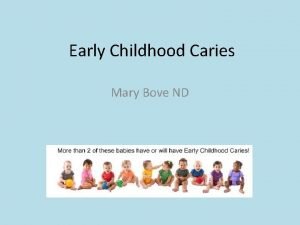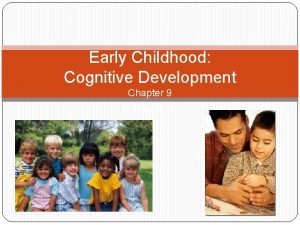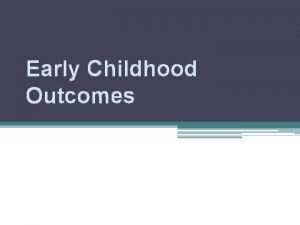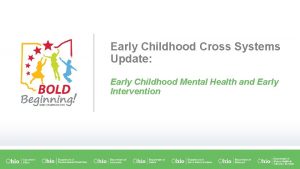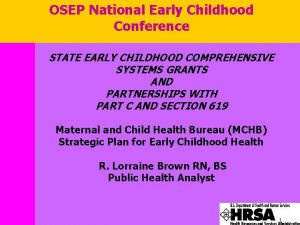EARLY CHILDHOOD EDUCATION CHILD FAMILY COMMUNITY INSTRUCTIONAL DESIGN

















- Slides: 17

EARLY CHILDHOOD EDUCATION CHILD, FAMILY & COMMUNITY INSTRUCTIONAL DESIGN PLAN CHAMPA S. PERERA CUR/516 NOVEMBER 7, 2016 PROF. SHIRLEY BURNETT

PHASE 1 • Description Target Audience • Learners will be coached to * Pre-school Teachers, Directors, and Administrators. educate young children of pre-school age in an environment of a Child * Educators working in the Field of Early Childhood Education Care Center. * Learners with experience working in the field with their own skills, • This training is a requirement Community knowledge, beliefs, and attitudes. Care Licensing Division for any individual in this field. • Focus on this training course is to support * Males, females ages 18 years and above. * Basic requirement – High School Diploma, and a knowledge of the needs of social emotional, physical, and Early Childhood Education. Additionally, reading and writing intellectual development of children in their skills. early years of life. • Learners will analyze the relationship with Child, family and Community.

PHASE 1 • Delivery modality and Length of Training Course ADDIE MODEL A - Analyze D - Design D - Development I - Implementation E- Evaluation • Length of Training – Two full days (Weekend) 8 -hour session per day with two 15 minute breaks and one-hour lunch break on each day. • Training is conducted in a traditional classroom setting with face-to-face interaction.

PHASE 1 • Goals – Child, Family, and Community • To understand the relationship between child, family, and community to promote socialization and interaction. • To develop a strong, healthy, and an emotional relationship in the Child Care Environment. • To gain experience in using community resources and services for the benefit of the children in their community.

PHASE 11 Course Objectives • Focus on the dynamics between child, family & Community with cultural and social influences for child’s social and emotional well-being. • To develop an awareness with the learners own personal history, experiences, views, and expectations, and how the learners can use these experiences with their teaching styles to understand the needs of child, family, and community. • Discuss and develop skills to understand the availability and variety of community services available for the community, and how these services can be used to the well-being of the children and families.

PHASE 11 • Learning Environment • Project-based learning • Collaborative learning • Critical thinking skills

PHASE 11 Instructional Strategies and Activities • Students are delivered with homework assignments at the time of enrollment • Practicum attendance for observations up to 45 hours in an Early Childhood Environment • Autobiography presentation of each student. Students will critically analyze of who you are, and how the family has been influential in forming their identity, and the influences. • Cultural activity – Personality and character development that represent the learners culture. • Community Assignment – Students are required to research the agencies in their community that provides a helpful service for the families. • Media Advertising – Students are required to research for advertisements that reflects todays society.

PHASE 11 Instructional Technology • Power point presentations • Lectures • Group activities • Text book – Child, family & Community (by Janet Gonzalez-Mena) • DVD’s related to Child, family & Community in Child Care Environment

PHASE 111 Length of Course • Two days (weekends) • 8: 00 a. m. – 4: 00 p. m. – 8 hour sessions on each day with breaks, and one hour lunch break. • Anticipated start date – November 13 & 14, 2016

PHASE 111 People involved in Implementation 1. Ms. Cynthia Brown, Program Director 2. Senior Professors of Laguna Technical College 3. Mr. Arturo Jimanez – Administrator, Laguna Technical College

PHASE 111 Needed Resources • Text book – Child, Family, and Community by Janet Gonzales-Mena. • Access for computers and Internet for Research. • Hands on materials – Implemented by the educator • Equipment for Power point presentation

PHASE 111 Implementation and Building Interest • Laguna Technical College website – Website is for Early Childhood Education • Flyers are mailed to all pre-schools that are in operation in Southern California • Building interest and commitment at the time of entrance counselling • Evaluations at the time of Entrance counselling

PHASE 111 • Formative Assessment • 1 st Stage - Design Review (Needs, Task, and Learner Analysis) • 2 nd Stage - Reviews with experts ( Program Director, Senior Professors, Administrator of Laguna Technical College) • 3 rd Stage - Learner Validation ( Group evaluations) • 4 th Stage - Evaluations and Feedback

PHASE 1 V Criteria for Determining Outcome of Course • Completing the product outcome of the training course - Child, Family, and Community • Meeting goals and objectives of the instructional plan • Meeting goals and objectives of the student learners • Creating an instructional design to analyze, design, develop, and implement to be successful to determine if the learner has reached a high level of success to accomplish the goals through evaluations.

PHASE 1 V Evaluation Instruments created are • Homework assignments • True/False questions • Short-answer questions • Multiple choice questions

PHASE 1 V Future decision making • Progress • Course duration • Certificate of Completion

REFERENCES: • Brown, A. , & Green, T. D. (2011). The essentials of instructional design: Connecting fundamental principals with process and practice (2 nd ed. ). Boston, MA: Allyn and Bacon • A Practical Guide" (1995). "Planning and Conducting Needs Assessments. Retrieved from https: //www 2. ed. gov/admins/lead/account/compneedsassessment. pdf on October 2, 2016. • Lee, H. , & Lim, C. (2012). Peer evaluation in blended team project-based learning: What do students find important? Journal of Educational Technology & Society, 15(4), 214. Retrieved from http: //search. proquest. com/docview/1287025373? accountid=458 • Wlodkowski, R. J. , & Ginsberg, M. B. (2010). Teaching intensive and accelerated courses: Instruction that motivates learning. John Wiley & Sons Inc.
 Middle childhood and adolescence
Middle childhood and adolescence Ecetp.pdp.albany.edu.elearning
Ecetp.pdp.albany.edu.elearning Acecqa self assessment tool
Acecqa self assessment tool Trends in early childhood education
Trends in early childhood education Early childhood education in pakistan
Early childhood education in pakistan Early childhood education in bangladesh
Early childhood education in bangladesh Pedagogical leadership in early childhood
Pedagogical leadership in early childhood Associates in early childhood education jobs
Associates in early childhood education jobs Attainment targets barbados
Attainment targets barbados Queen's university early childhood education
Queen's university early childhood education Connecticut early childhood education cabinet
Connecticut early childhood education cabinet Operant conditioning in early childhood education
Operant conditioning in early childhood education Holistic approach in early childhood education
Holistic approach in early childhood education Swot analysis early childhood education
Swot analysis early childhood education Ethical dilemmas in early childhood education
Ethical dilemmas in early childhood education Early childhood education
Early childhood education Bf skinner early childhood education
Bf skinner early childhood education California community college chief instructional officers
California community college chief instructional officers



